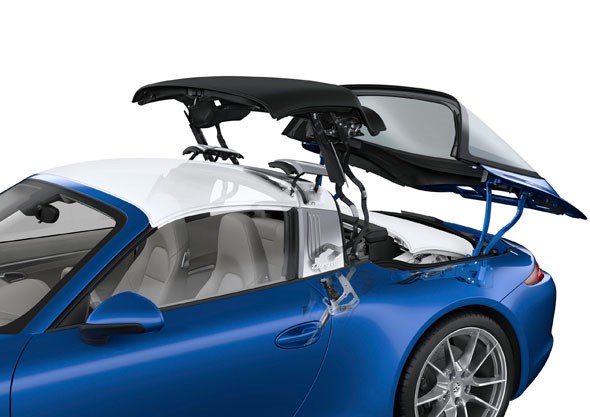Meet the most distinctive 911 of the current 991 family– the new 2014 Porsche 911 Targa. This is the open-top model for those who don’t want the full convertible experience – and it’s only available in the wide-hipped four-wheel drive bodyshell.
The new Targa is a striking design, echoing the 1965 original with its fixed rollover bar. The alloy-look hoop is locked in place and capped with a wide, wraparound rear window, giving the Targa the best of both worlds (on paper, at least): the style of a coupe with the al fresco option of a convertible. The last 997-gen Porsche Targa had more of a sunroof than a hood.
Porsche sells two 991 Targas: the Targa 4, costing £86,281 and powered by the regular Carrera’s 3.4-litre flat six, and the Targa 4S, priced at £96,316 and enjoying the more powerful 3.8 from the Carrera S. It’s the more powerful range-topper we test here, in seven-speed manual format.
Porsche 911 Targa (2014): first impressions
The Targa makeover lends a renewed presence to the 911 shape. We’ve become so used to the iconic rear-engined, soap-bar design that it’s rare to stumble upon one that makes you look twice. The Targa achieves that, where a more common 911 Cabriolet just wouldn’t.
You can activate the roof from the key fob: the huge goldfish bowl rear window hinges up, the hard fabric roof panel flips back and folds away, then the glass canopy drops again – while the metallic rollover hoop remains fixed in place. It’s an 18sec masterclass in street theatre, but you can’t drop the top unless you’re at a standstill. A pity, when so many rivals go topless on the move at low speeds.
It’s a cocooned sensation driving the Targa al fresco. You’re at once open-air and yet enclosed, but it split opinion somewhat in the CAR office. Some found it too breezy with the roof open (though they admitted they hadn’t used the wind deflector) while others – me included – thought it was the ideal halfway house between coupe and cabriolet. It’s certainly darn stylish.
But £100k for a 991 Targa!
Yes, there’s no getting away from the expense of the Targa. Our 911 Targa 4S lists at £96,316, compared to £92,108 for a Carrera S Cabriolet.
And that’s before you start ticking boxes on the options list. Niceties such as the Porsche Sports Exhaust (£1772), satin Carrera S 20in alloy wheels (£538) and SportDesign three-spoke paddle-shift steering wheel (£283) rapidly add up. You can even spend £138 on having the Porsche crest embossed on the headrests, damnit!
No wonder our Targa 4S nudged upwards to a final on-the-road price of £102,203…
How does the Porsche 911 Targa 4S drive?
You may have got used to the ubiquity of the 911 shape – and you’re probably tired of rave reviews about its driving manners too. But this is evolution in action. Porsche has had over half a century refining the 911 recipe, so it should come as no surprise to hear the Targa is a slick drive.
Fire up the 3800cc flat six and it barks into life with a purposeful, refined clatter. This engine may be more anodyne than the air-cooled motors from 993 and before, but it’s still got real character. Drop the Targa’s hood and you can hear its raspy nature even better and the flat six thrives on revs. Wringing it out to the redline on a cross-country blat is a lesson in Driver Entertainment And The Art of Naturally Aspirated Engines 1980-2014.
Out on the open road is where the Targa scores highest. All 911 virtues are intact – plus a few vices – and the loss of a fixed roof has minimal impact. The most burning memory of driving the 991 Targa is the inherent rightness of the controls. Doubters should slot themselves into a new 991-generation model to feel how precise, how measured every touch point is. You mete out millimetres of throttle input here, a nudge of steering there – and the 911 responds instantly. It remains a scalpel of a driving tool and the four-wheel drivetrain has all but eliminated any of the waywardness previously associated with the rear-engined sports car. Traction is never an issue.
Our car’s seven-speed manual transmission was slightly at odds with its softer, Targa focus – wouldn’t a PDK auto be better suited? – but it means you can punt the 911 along with full control. Slotting seventh gear remains a triumph of dexterity over mental stumbling with five different vertical gates to choose from; top gear remains out of reach unless you’re in the fifth/sixth plane. But the quality of change and the way it dovetails with the clutch remain a masterclass in mechanical feel. It’s so well set up even average drivers can prod and roll onto pedals with their heels and toes.
What don’t we like about the 991 Targa?
There was a slight creaking from the whole enormous roof shebang on occasion, but most of the time the Targa top worked faultlessly. We particularly admire the stiff roof panel which feels to all intents and purposes as solid as a steel lid.

Decide for yourself whether the Porsche cabin has become a button-festooned mess or a welcome relief from the scourge of the multi-controller, minimalist cabins that have become in vogue. To these eyes, the centre console is just too busy, but the lack of sub-menus and confusing operation is a boon.
Verdict
We were smitten with the new Porsche 911 Targa. It’s a rare glimpse of Porsche letting its hair down with an overtly pastiche, retro design. For many it will offer the perfect halfway house between the coupe and convertible – and the icing on the cake is how it mixes regular Carrera 4S go (184mph, 0-62mph in 4.8sec) with a sense of style and everyday usability (those occasional rear seats, the real possibility of 30mpg in everyday driving). We were converted.